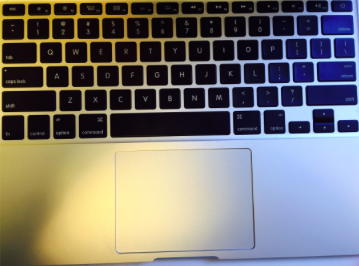“I think they wanted to be more in line with the times,” said senior Olivia Domowitz when asked why she thought WIS implemented the new device system in classrooms.
Sean Moran, who was one of the main figures in charge of installing the new system of each student having bringing their own device to class, would certainly agree with this statement, although his reasoning was slightly different. “At the end of the day,” said Mr. Moran, “we felt like it was going to enhance what was happening in the classroom.” The system, which requires every student to bring either an laptop or tablet to class, completely changes the way that certain classes are run in both positive and negative ways.
The main benefits of the “one-to-one” system are fairly evident. Firstly, the capabilities of the internet can prove extremely powerful in a learning context. As economics teacher James Martin put it, “the ability to get any information you want really quickly is helpful,” and this is typified by search engines like Google, which enable students to do research instantly within the class.
In addition, the presence of laptops in a classroom can add new dimensions to the students’ learning experience due to the multitude of available online platforms, such as Google Docs, Prezi, and Moodle, among others. “If teachers thought of an idea halfway through class, the system opens up the class and allows the teachers to do activities if everyone has a device all the time,” Moran says. The multi-faceted nature of the Internet allows for quick adjustments and more room for improvisation from the teachers.
Despite these two positives, there are undoubtedly drawbacks of the one-to-one system, and the first one is the financial aspect. The types of devices required can cost over $1000, depending on the product, and Moran said that the school had to ask what the best financial model was for the community at large. In the end however, the educational benefits of the system made it worth asking students to get a device.
From the teachers’ perspective, the second and more important shortcoming of students having devices in class is the element of distraction. When asked whether he felt that his students using devices get more distracted in his class, Martin bluntly responded, “yes.” “It’s like taking a trip with a lot of other things that can catch your interest enough to lead you somewhere else,” he said before emphasizing the negative effects that it can have for teachers who are meant to discuss a certain topic. However,Moran believes the distraction to be entirely controllable by the teachers: “The people in charge are going to treat it like any other distraction factor, technological or otherwise in the classroom.” Referring to certain management techniques that teachers must use, he made it evident that he did not see this as a bigger problem than other potential distractions. Yet the problem still remains that a teacher cannot always see whether students are on task or rather using news, social media, or gaming sites.
When it comes to the students’ perspective, distraction is most definitely a factor. Out of 88 students who answered a survey on the one-to-one system, only 20, or 23%, of them said that device distraction was never an issue in class. The rest responded that the device were “sometimes”, “often”, or “very” distracting in the context of a classroom. Thomas Hagan, a junior, mentioned that having “possibilities at your fingertips” can be a hindrance to learning, referring to various multimedia that can be found on devices.
On the other hand, one of the most important positives for students is the aspect of continuity. The transition from working at school to at home and vice versa becomes significantly easier with the same device, as documents and pictures are more accessible from the same laptop or tablet. Although platforms such as Google Drive help to facilitate these types of transitions from different devices, using the same laptop for a whole year can save students a lot of trouble in terms of saving work in folders that are easy to maneuver.
The one aspect of the new system that has a more ambiguous effect is note-taking. Out of those 88 students surveyed, 50 responded that taking notes on paper is easier, 19 said that taking notes on a computer is easier, and 19 answered they were the same. Despite the majority voting for paper, the arguments for both sides are quite obvious: on paper, it is often easier to draw diagrams free-hand, while being able to write notes in a specific train of thought, rather than being confined by margins in the formatting of a Google Doc, for example. On a computer, however there is the benefit of organization. Freshman Ali Lahrech likes that iPads “help note-taking because [the notes] are all in one place and you don’t have to look for your notes frantically.” The benefit of the cloud is the convenience of virtually unlimited storage space and the fact that documents can be extremely easy to find. It saves what Mikaela refers to as “piles of papers,” which is a bonus for students, but also a pro in terms of the environment and not having to use up a lot of paper.
WIS is not the only school to wonder about the implications of this relatively new system. For example, Cornell University experimented with a study called “The Laptops and the Lecture” in 2003. To conduct the experiment, half of a class was allowed to use computers unlimitedly in class, while the other half had to keep all devices closed during a lecture. Results showed that students who were not using computers performed better on a post-lecture quiz, which shows that multitasking can be extremely detrimental to learning in a classroom environment.
Although computers can have destructive consequences for students’ learning, the effect on WIS will not necessarily be negative: it will be what the school makes of it. If used correctly, the one-to-one system can be an extremely powerful tool that allows teachers to deepen their students’ understanding of a topic and students to expand their knowledge. In order for effects to be altogether positive, teachers must maintain control of their classrooms and keep students on task.
After all, there must be a reason that this system is becoming more and more prominent in the world. As Moran said, There were many schools that did this before us, and there will be more after us.” Furthermore, he likes that WIS is not the first school to test out the system: “one of the things we did right is that we were able to look at them, how they did it, and what went right or wrong.” Knowing the potential consequences is a massive advantage for WIS because it can learn from others’ experiences with the system.
Clearly, devices play a role in the educational method of the future. And WIS, as usual, is in line with the times.

Having a device can be much more efficient than stacks of books and papers. The keyboard is one of the platforms for the new educational system at WIS. Photo credit: Rohan Subramanian

Computers often lead to distractions. Photo credit: Rohan Subramanian
By Rohan Subramanian

































































